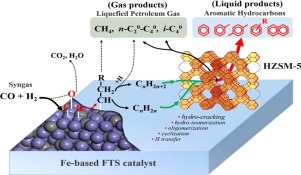Applied Catalysis A: General ( IF 5.5 ) Pub Date : 2018-01-10 , DOI: 10.1016/j.apcata.2018.01.012 Yuebing Xu , Dapeng Liu , Xiaohao Liu

|
Direct conversion of syngas (CO + H2) toward aromatics has been demonstrated over a hybrid catalyst system composed of Fe-based FTS catalyst and HZSM-5 zeolite. Over the catalyst system, the aromatics were highly selective in the liquid hydrocarbon products with a content greater than 95%, and 70–90% of the aromatics were concentered on the toluene, xylene and 3C-branched alkylbenzenes. In this study, we systematically investigated the effects of reaction conditions (temperature, pressure, space velocity and H2/CO ratio) and catalyst combination (Si/Al ratio of zeolite, weight ratio of HZSM-5 to Fe-based catalyst, metal modification of HZSM-5, and kind of Fe-based catalyst) on the CO conversion, selectivity to aromatics, aromatic distribution, and catalyst deactivation, combining with some characterization technologies (XRD, BET, NH3-TPD, H2-TPR, TG and 27Al NMR). The obtained results show that HZSM-5 zeolite was the crucial component for aromatic formation. Excessive loading of the zeolite in bed would greatly suppress the carburization of reduced Fe into Fe carbides as well as CO dissociation on the Fe carbides because of the increasingly unfavorable direct contact between the acidic HZSM-5 and Fe-based catalyst, resulting in a remarkably lower CO conversion. HZSM-5 zeolite having high Brønsted acidity favored the formation of aromatics with a high content in liquid phase. However, as HZSM-5 had originally lower Brønsted acidity or the Brønsted acidity decreased during the aromatic synthesis due to more coke deposition, the selectivity to hydrocarbons in liquid phase gradually shifted to iso-paraffins rather than aromatics. Reactions operated over FeMn-HZSM-5 catalyst system at lower temperature or higher pressure led to an easier deactivation of HZSM-5 mainly from coke deposition. Compared with the FeMn-HZSM-5, FeK-HZSM-5 deactivated seriously at same conditions probably due to heavier and olefinic primary hydrocarbons over the FeK catalyst. In addition, 27Al NMR showed that extraction of framework Al by in situ formed H2O and CO2 could be ignorable for the HZSM-5 deactivation. More detailed results and discussion from abundant experimental work on clarifying their effects on the aromatic synthesis can be found in the article.
中文翻译:

杂化铁基费-托催化剂和HZSM-5沸石将合成气转化为芳烃
在由铁基FTS催化剂和HZSM-5沸石组成的混合催化剂体系上,已经证明了合成气(CO + H 2)向芳烃的直接转化。在整个催化剂体系中,芳烃在液态烃产品中的选择性高,含量超过95%,其中70-90%的芳烃集中在甲苯,二甲苯和3C支链烷基苯上。在这项研究中,我们系统地研究了反应条件(温度,压力,空速和H 2)的影响。/ CO比)和催化剂组合(沸石的Si / Al比,HZSM-5与铁基催化剂的重量比,HZSM-5的金属改性以及铁基催化剂的种类)对CO转化率,对芳烃的选择性,芳香族分布和催化剂失活,并结合一些表征技术(XRD,BET,NH 3 -TPD,H 2 -TPR,TG和27Al NMR)。所得结果表明,HZSM-5沸石是形成芳烃的关键组分。由于酸性HZSM-5和铁基催化剂之间越来越不利的直接接触,沸石在床层中的过量负载将极大地抑制还原的铁渗入铁碳化物中的渗碳以及在铁碳化物上的CO分解。较低的CO转化率。具有高布朗斯台德酸度的HZSM-5沸石有助于形成液相中含量高的芳族化合物。然而,如HZSM-5原本降低布朗斯台德酸度或布朗斯台德酸性的芳族合成过程中,由于更多的焦炭沉积降低,选择性液相烃逐渐转移到异-石蜡而不是芳烃。在较低的温度或较高的压力下,在FeMn-HZSM-5催化剂体系上进行的反应导致HZSM-5的失活更容易,主要是由于焦炭沉积。与FeMn-HZSM-5相比,FeK-HZSM-5在相同条件下会严重失活,这可能是由于FeK催化剂上的重烃和烯属伯烃所致。此外,27 Al NMR表明,通过原位形成的H 2 O和CO 2萃取骨架Al对于HZSM-5失活可能是可忽略的。在文章中,可以找到更详细的结果和大量实验工作的讨论,以阐明它们对芳烃合成的影响。


























 京公网安备 11010802027423号
京公网安备 11010802027423号